Ying Yuan on:
[Wikipedia]
[Google]
[Amazon]
 Ying Yuan () were stamped blocks of gold bullion. This was an early form of
Ying Yuan () were stamped blocks of gold bullion. This was an early form of
What is the Earliest Gold Coin in China ?
Chu (state) Coins of ancient China Gold coins {{china-stub
currency
A currency, "in circulation", from la, currens, -entis, literally meaning "running" or "traversing" is a standardization of money in any form, in use or circulation as a medium of exchange, for example banknotes and coins.
A more general ...
that could be considered a precursor to gold coins
A gold coin is a coin that is made mostly or entirely of gold. Most gold coins minted since 1800 are 90–92% gold (22 karat), while most of today's gold bullion coins are pure gold, such as the Britannia, Canadian Maple Leaf, and American Bu ...
. They were issued by the ancient Chinese state of Chu
Chu, or Ch'u in Wade–Giles romanization, (, Hanyu Pinyin: Chǔ, Old Chinese: ''*s-r̥aʔ'') was a Zhou dynasty vassal state. Their first ruler was King Wu of Chu in the early 8th century BCE. Chu was located in the south of the Zhou ...
during the Warring States period
The Warring States period () was an era in History of China#Ancient China, ancient Chinese history characterized by warfare, as well as bureaucratic and military reforms and consolidation. It followed the Spring and Autumn period and concluded ...
between the 400s and late 200s BCE.
Names
Because these gold blocks are inscribed withChinese characters
Chinese characters () are logograms developed for the writing of Chinese. In addition, they have been adapted to write other East Asian languages, and remain a key component of the Japanese writing system where they are known as ''kanji ...
they are variously known as ''yin zi jin'' (), ''jin ban'' (), or ''gui bi'' ().
History and overview
The oldest ones known are from about the 5th or 6th century BCE. They consist of sheets of gold 3-5mm thick, of various sizes, with inscriptions consisting of square or round stamps in which there are one or two characters. They have been unearthed in various locations south of the Yellow River indicating that they were products of the State of Chu. One of the characters in their inscription is often a monetary unit or weight which is normally read as ''yuan'' (). Pieces are of a very variable size and thickness, and the stamps appear to be a device to validate the whole block, rather than a guide to enable it to be broken up into unit pieces. Some ''ying yuan'' contain theChinese characters
Chinese characters () are logograms developed for the writing of Chinese. In addition, they have been adapted to write other East Asian languages, and remain a key component of the Japanese writing system where they are known as ''kanji ...
ying yuan (郢爰).
Another inscription that is sometimes found on these ancient gold blocks is ''chen yuan'' (陳爰).
Some specimens have been reported in copper, lead, or clay. It is probable that these were funeral money, not circulating currency, as they are found in tombs, but the gold ones are not.
See also
*Economic history of China
The economic history of China is covered in the following articles:
* Economic history of China before 1912, the economic history of China during the ancient China and imperial China, before the establishment of the Republic of China in 1912.
** ...
* Ancient Chinese coinage
Ancient Chinese coinage includes some of the earliest known coins. These coins, used as early as the Spring and Autumn period (770–476 BCE), took the form of imitations of the cowrie shells that were used in ceremonial exchanges. The s ...
References
External links
What is the Earliest Gold Coin in China ?
Chu (state) Coins of ancient China Gold coins {{china-stub